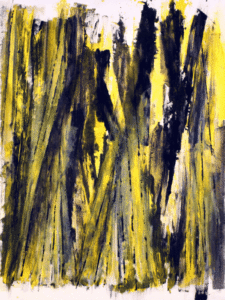By Ellie Gavin || Managing Editor
This month at the Philips Museum, the Dana Gallery will feature a new exhibit called Reach, with artwork by F&M Professor of English, Padmini Mongia.
 Professor Mongia has been painting for fifteen years. This is her second solo show at the Phillips: her first was named “Shapes of Nature,” and premiered in 2005. According to Mongia, Reach shows the movement from verbal arts to visual arts. Ink and acrylic are used on canvas for the paintings, which include those on the larger scale and those on the smaller scale.
Professor Mongia has been painting for fifteen years. This is her second solo show at the Phillips: her first was named “Shapes of Nature,” and premiered in 2005. According to Mongia, Reach shows the movement from verbal arts to visual arts. Ink and acrylic are used on canvas for the paintings, which include those on the larger scale and those on the smaller scale.
Mongia says that the primary way that this exhibit has changed from the last is the way that it plays with scale. “The large pieces are very large and the small ones very small.”
Additionally, the works play with different artistic mediums, using both ink and acrylic. “I don’t have an opinion on what artists in general should do or not. I am interested in different mediums, and you see some of that in this show. I have increasingly been drawn to ink and I like the way ink and acrylic correlate to each other. The flow of the ink is mirrored in the acrylic (or can be), but the acrylic is also thicker and heavier and denser.”
When asked about the inspiration behind her exhibit, Mongia says, “I don’t think this is a question which may be answered easily. I don’t know if “inspiration” is the word i would use to talk of my works. Instead, I would prefer to talk of the materials I use to make my art and/or the engagement with color and form.”
In fact, Mongia would advise young artists to give up on the idea of inspiration altogether. “I would tell them not to look for inspiration. Inspiration is a false god. I’d tell them to keep doing their work and to let their work tell them where to go next.”
When asked what she has learned through painting that has deepened her understanding of other art forms, Mongia says, “Every form of expression requires commitment, great commitment. In addition to the paintings I’ve made that have worked, there are many others that have not. The same is true of other forms of expression. Some things work and some don’t, but you only know what does or doesn’t by working.”
If you are interested in learning more about Professor Mongia’s work, there is a short artist’s talk on November 17, from 5:00pm-6:30pm to discuss Reach and abstraction in India and Pakistan.
Junior Ellie Gavin is the Managing Editor. Her email is fgavin@fandm.edu.